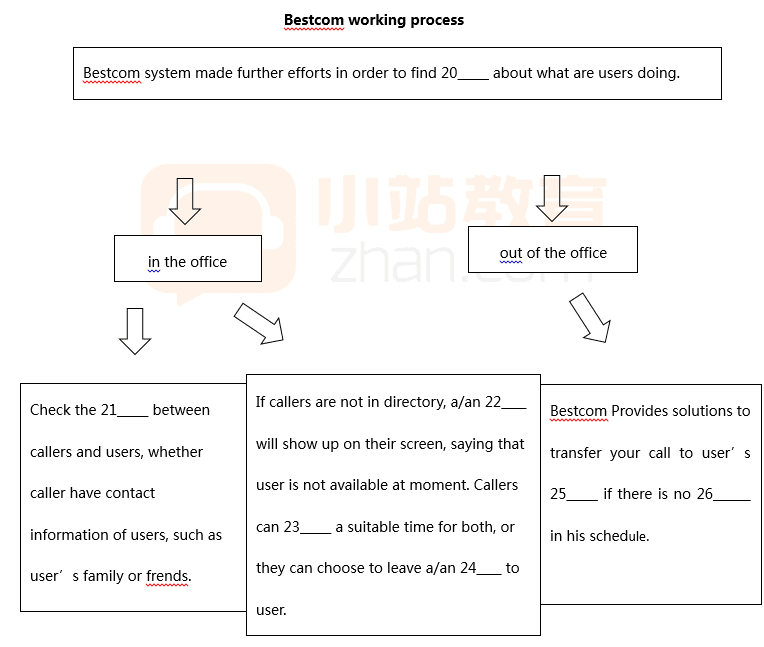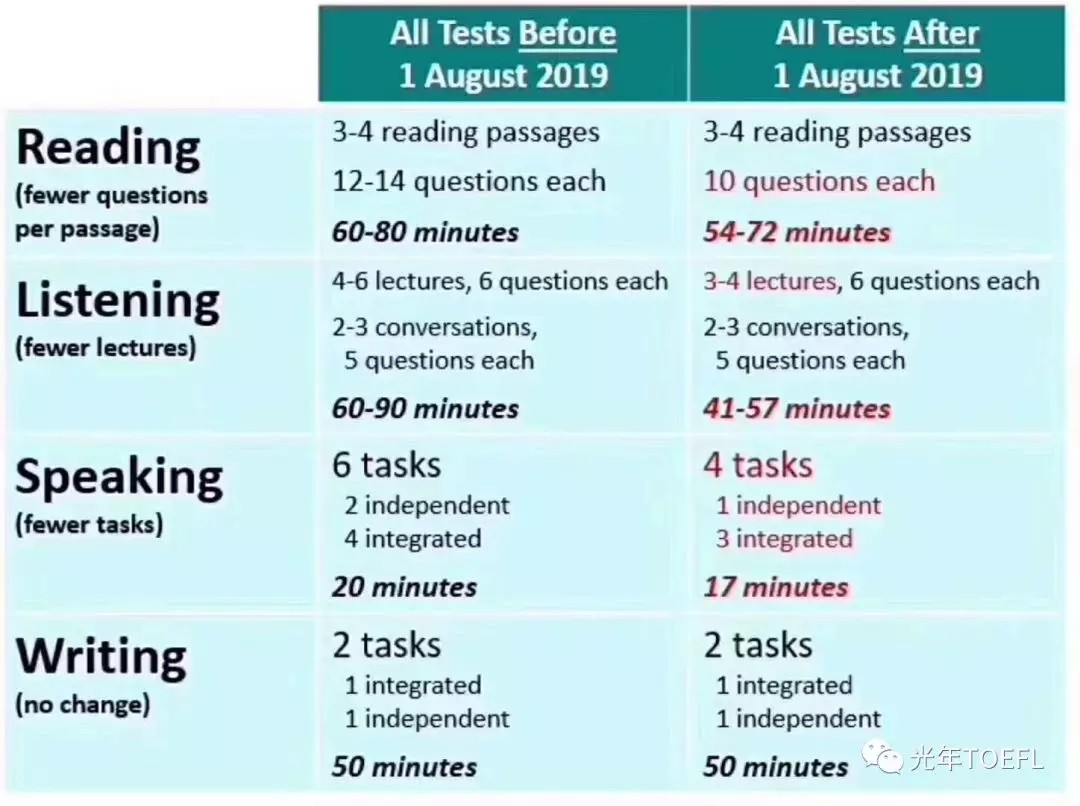托福阅读部分有很多细节需要考生在开始备考前就做到心里有数,比如阅读考试时间等等,今天小编给大家带来托福阅读备考须知基本常识解题心得分享,希望能够帮助到大家,下面小编就和大家分享,来欣赏一下吧。
托福阅读备考须知基本常识解题心得分享
托福阅读考试时间细节介绍
15分钟一篇,一篇13/14道题。(官方要求是20分钟一篇)
13道题中除了4道词汇题(30‘’)1道多选题(1’30‘’)之外,其他题目基本(1‘)一般是在第三段/第四段,大概第8题/第9题的样子,是一段会出2道理解题的段落。题目编排,近几年的官方真题Official一般第一篇第二篇文章偏难,生词多,第三篇简单难度类似早期官方真题Official。
在题目上一般是(细节 词汇,细节 作用, 细节 词汇, 细节 词汇 改写, 细节 词汇, 黑点 大意)规律就是每一段都会出细节题(In paragraph n...)再加一道其他题,早期一段只有一道题的情况几乎不存在了。
简单的文章可能会出比较难的大意题,尤其是对比型的简单文章。用上面的标准控制时间,用下面的方法去读的话,20分钟一般都是够用的。
托福阅读高分常见障碍分析
速度:1’大概150-170字,生词量一般而且前后不出现感觉自相矛盾需要停下来想的情况下。
选项:词汇量一般,有时词汇题的相似词汇不造句都感觉不出区别。
托福阅读备考真题训练技巧讲解
1,粗看下文章的段数,对每段大概几道题有个预期。(比如只有5段,那长段肯定是3道题)粗看每段第一句话,对文章的整体意思心中有数。
2,每段段首变成中文理解,以迅速的进入状态,并记忆主要意思。(就算只有一道词汇题,这段的段首也要读)
3,每读一段整理一次逻辑,A支持的观点是,A的观点的问题是B的观点是。(记忆法,图像帮助理解,逻辑帮助记忆,生成图像来理解含义,对逻辑部分用色彩记忆红黄绿记忆法,每一段的第一句作为逻辑中心标记黄色。
这段如果讲倒推如原因,在脑中的逻辑框架就在红色的区域生成记忆,如果正推将后果等就在绿色区域生成图像,读完全文留下来的会是每一排都是红黄绿三色的逻辑关系,每一段都纵向罗列,如下)红——黄——绿
4,鉴于每段都会出细节题,如果有词汇题等先只看一句话,做完了要看到细节题问的什么再看文章,鉴于有四个选项,选一个对的或者不对的,看的时候自己要边看边总结,比如总结出三个步骤, 解释了三个方面的问题,或者其他。5,要检查,每个不确定的题都标上guess回来看,我不确定的题错的概率还是非常高的。如果不走神的理解全文,一般15分钟是够的,还能剩下几分钟检查。
托福阅读实用做题策略介绍
词汇题、句子改写题——只读该句不读完整段(30‘ . + 1’.1)耗时3分钟
词汇题看好单词的词性、发出者(是人,是物),保持一致的最对,看这一句即可。
In the past,whole cities grew from the arduous task of cutting and piling stone upon. Some ofthe world’s finest stone architecture can be seen in the ruins of the ancient Inca city of Machu Picchu high in the eastern Andes Mountains of Peru.
The word “arduous” in the passage is closest in meaning to
A. Difficult B. Necessary C. Skilled D. Shared
猜词是保证不了完全准了,根据意思,这道题排除BD,剩下AC很是纠结,但是看task本身,skilled task这种说法小奇怪,一般是skilled workers,所以选A
词汇题一直是难点超爱错,猜出来的,如果有时间检查一定要再看一下,从ETS出题的角度考虑。
托福阅读真题原题+题目
By the turn of the century, the middle-class home in North American had been transformed. The flow of industry has passed and left idle the loom in the attic, the soap kettle in the shed, Ellen Richards wrote in 1908. The urban middle class was now able to buy a wide array of food products and clothing — baked goods, canned goods, suits, shirts, shoes, and dresses. Not only had household production waned, but technological improvements were rapidly changing the rest of domestic work. Middle-class homes had indoor running water and furnaces, run on oil, coal, or gas, that produced hot water. Stoves were fueled by gas, and delivery services provided ice for refrigerators. Electric power was available for lamps, sewing machines, irons, and even vacuum cleaners. No domestic task was unaffected. Commercial laundries, for instance, had been doing the wash for urban families for decades; by the early 1900's the first electric washing machines were on the market.
One impact of the new household technology was to draw sharp dividing lines between women of different classes and regions. Technological advances always affected the homes of the wealthy first, filtering downward into the urban middle class. But women who lived on farms were not yet affected by household improvements. Throughout the nineteenth century and well into the twentieth, rural homes lacked running water and electric power. Farm women had to haul large quantities of water into the house from wells or pumps for every purpose. Doing the family laundry, in large vats heated over stoves, continued to be a full day's work, just as canning and preserving continued to be seasonal necessities. Heat was provided by wood or coal stoves. In addition, rural women continued to produce most of their families' clothing. The urban poor, similarly, reaped few benefits from household improvements. Urban slums such as Chicago's nineteenth ward often had no sewers, garbage collection, or gas or electric lines; and tenements lacked both running water and central heating. At the turn of the century, variations in the nature of women's domestic work were probably more marked than at any time before.
1. What is the main topic of the passage ?
(A) The creation of the urban middle class
(B) Domestic work at the turn of the century
(C) The spread of electrical power in the United States
(D) Overcrowding in American cities.
2. According to the passage , what kind of fuel was used in a stove in a typical middle-class household?
(A) oil
(B) coal
(C) gas
(D) wood
3. Which of the following is NOT mentioned as a household convenience in the passage ?
(A) the electric fan
(B) the refrigerator
(C) the electric light
(D) the washing machine
4. According to the passage , who were the first beneficiaries of technological advances?
(A) Farm women
(B) The urban poor
(C) The urban middle class
(D) The wealthy
5. The word reaped in line 23 is closest in meaning to
(A) gained
(B) affected
(C) wanted
(D) accepted
6. Which of the following best characterizes the passage 's organization?
(A) analysis of a quotation
(B) chronological narrative
(C) extended definition
(D) comparison and contrast
7. Where in the passage does the author discuss conditions in poor urban neighborhoods?
(A) lines 3-5
(B) lines 6-7
(C) lines 8-9
(D) lines 22-23
PASSAGE 45 BCADA DD
托福阅读真题原题+题目
Pennsylvania's colonial ironmasters forged iron and a revolution that had both industrial and political implications. The colonists in North America wanted the right to the profits gained from their manufacturing. However, England wanted all of the colonies' rich ores and raw materials to feed its own factories, and also wanted the colonies to be a market for its finished goods. England passed legislation in 1750 to prohibit colonists from making finished iron products, but by 1771, when entrepreneur Mark Bird established the Hopewell blast furnace in Pennsylvania, iron making had become the backbone of American industry. It also had become one of the major issues that fomented the revolutionary break between England and the British colonies. By the time the War of Independence broke out in 1776, Bird, angered and determined, was manufacturing cannons and shot at Hopewell to be used by the Continental Army.
After the war, Hopewell, along with hundreds of other iron plantations, continued to form the new nation's industrial foundation well into the nineteenth century. The rural landscape became dotted with tall stone pyramids that breathed flames and smoke, charcoal-fueled iron furnaces that produced the versatile metal so crucial to the nation's growth. Generations of ironmasters, craftspeople, and workers produced goods during war and peace-ranging from cannons and shot to domestic items such as cast-iron stoves, pots, and sash weights for windows.
The region around Hopewell had everything needed for iron production: a wealth of iron ore near the surface, limestone for removing impurities from the iron, hardwood forests to supply the charcoal used for fuel, rushing water to power the bellows that pumped blasts of air into the furnace fires, and workers to supply the labor. By the 1830's, Hopewell had developed a reputation for producing high quality cast-iron stoves, for which there was a steady market. As Pennsylvania added more links to its transportation system of roads, canals, and railroads, it became easier to ship parts made by Hopewell workers to sites all over the east coast. There they were assembled into stoves and sold from Rhode Island to Maryland as the Hopewell stove. By the time the last fires burned out at Hopewell ironworks in 1883, the community had produced some 80,000 cast-iron stoves.
1. The word implications in line 2 is closest in meaning to
(A) significance
(B) motives
(C) foundations
(D) progress
2. It can be inferred that the purpose of the legislation passed by England in 1750 was to
(A) reduce the price of English-made iron goods sold in the colonies
(B) prevent the outbreak of the War of Independence
(C) require colonists to buy manufactured goods from England.
(D) keep the colonies from establishing new markets for their raw materials.
3. The author compares iron furnaces to which of the following?
(A) cannons
(B) pyramids
(C) pots
(D) windows
4. The word rushing in line 21 is closest in meaning to
(A) reliable
(B) fresh
(C) appealing
(D) rapid
5. Pennsylvania was an ideal location for the Hopewell ironworks for all of the following reasons
EXCEPT
(A) Many workers were available in the area.
(B) The center of operations of the army was nearby.
(C) The metal ore was easy to acquire
(D) There was an abundance of wood.
6. The passage mentions roads, canals, and railroads in line 25 in order to explain that
(A) improvements in transportation benefited the Hopewell ironworks
(B) iron was used in the construction of various types of transportation
(C) the transportation system of Pennsylvania was superior to that of other states.
(D) Hopewell never became a major transportation center
7. The word they in line 26 refers to
(A) links
(B) parts
(C) workers
(D) sites
8. The word some in line 28 is closest in meaning to
(A) only
(B) a maximum of
(C) approximately
(D) a variety of
PASSAGE 46 ACBDB ABC
托福阅读备考须知基本常识解题心得分享
下一篇:托福阅读提升不能只顾看课外书籍






